Mangiferin
Synonym(s):1,3,6,7-Tetrahydroxyxanthone C2-β-D -glucoside;Chinomin;Chinonin;Shamimin
- CAS NO.:4773-96-0
- Empirical Formula: C19H18O11
- Molecular Weight: 422.34
- MDL number: MFCD00075656
- EINECS: 624-757-7
- SAFETY DATA SHEET (SDS)
- Update Date: 2025-12-17 09:50:35
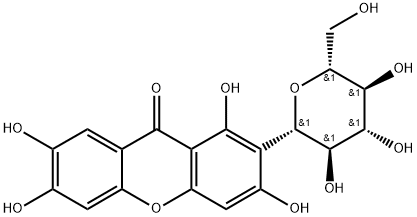
What is Mangiferin?
Description
Mangiferin is a plant natural polyphenol of C-glycosylxanthone structure and various pharmacological activities. It can be found in many plant species, among which the mango tree (Mangifera indica) is one of the primary sources. Mangiferin is also present in some medicinal herbs, influencing their therapeutic and preventive properties, and in honeybush (Cyclopia sp.), a popular South African herbal tea. Mangiferin dissolves well in water, so it can be easily extracted into infusions and decoctions. In the mangiferin molecule, four aromatic hydroxyl groups determine its strong antiradical and antioxidant properties. Mangiferin is also an efficient iron chelator, therefore preventing the generation of hydroxyl radicals in Fenton-type reactions[1].
Chemical properties
Yellow powder
The Uses of Mangiferin
Mangiferin is a xanthonoid, a chemical compound found in mangoes and in Anemarrhena asphodeloides rhizomes. Mangiferin has effect of hepatinica and choleretic, and is used to therapy hepatitis. Mangif erin is an anti-inflammatory, antivirotic, central nervous system inhibit function and immunologic suppression. Mangiferin has curative effect on chronic bronchitis. Mangiferin has cytotoxicity effec t on hepatocellular carcinoma ce1l, and may induce apoptosis. Mangiferin has the effect of antioxidation and delaying caducity.
The Uses of Mangiferin
MAO inhibitor, immunostimulant
The Uses of Mangiferin
Mangiferin is a xanthonoid, a chemical compound found in mangoes and in Anemarrhena asphodeloides rhizomes. Mangiferin has effect of hepatinica and choleretic, and is used to therapy hepatitis. Mangiferin is an anti-inflammatory, antivirotic, central nervous system inhibit function and immunologic suppression. Mangiferin has curative effect on chronic bronchitis. Mangiferin has cytotoxicity effect on hepatocellularcarcinoma ce1l, and may induce apoptosis. Mangiferin has the effect of antioxidation and delaying caducity.
Definition
ChEBI: A C-glycosyl compound consisting of 1,3,6,7-tetrahydroxyxanthen-9-one having a beta-D-glucosyl residue at the 6-position.
General Description
Mangiferin (MGF) is a natural bioactive polyphenol predominantly isolated from the Mangifera indica (Mango) tree. It has a xanthone glucoside structure. Mangiferin can also be found in other angiosperm plants and herbs.
Biochem/physiol Actions
Mangiferin has various pharmacological properties including antioxidant, anti-diabetic, anti-bacterial, cardioprotective, neuroprotective, and immunomodulatory activities. It has also displayed antidiabetic, antihyperlipidemic, and antiatherogenic properties in streptozotocin-induced diabetic rats. MGF exerts chemotherapeutic and chemo-preventative activities. It displays antioxidant, analgesic, and hepatoprotective activity against carbon tetrachloride-induced liver injury. MGF is a known accelerator of gastrointestinal transit (GIT).
References
[1] Adam Matkowski. “Mangiferin - a bioactive xanthonoid, not only from mango and not just antioxidant.” Mini reviews in medicinal chemistry 13 3 (2013): 439–55.
Properties of Mangiferin
| Melting point: | 269-270°C |
| storage temp. | 2-8°C |
| solubility | DMSO (Slightly, Sonicated), Methanol (Slightly), Pyridine (Slightly, Heated) |
| form | Solid |
| Boiling point: | 842.7±65.0 °C(Predicted) |
| Density | 1.843±0.06 g/cm3(Predicted) |
| pka | 6.09±0.20(Predicted) |
| color | Pale Yellow |
| Stability: | Hygroscopic |
| CAS DataBase Reference | 4773-96-0(CAS DataBase Reference) |
Safety information for Mangiferin
| Signal word | Danger |
| Pictogram(s) |
 Skull and Crossbones Acute Toxicity GHS06 |
| GHS Hazard Statements |
H300:Acute toxicity,oral |
| Precautionary Statement Codes |
P264:Wash hands thoroughly after handling. P264:Wash skin thouroughly after handling. P270:Do not eat, drink or smoke when using this product. P301+P310:IF SWALLOWED: Immediately call a POISON CENTER or doctor/physician. P405:Store locked up. P501:Dispose of contents/container to..… |
Computed Descriptors for Mangiferin
| InChIKey | AEDDIBAIWPIIBD-AZBPZEDSNA-N |
| SMILES | OC1=C([C@H]2[C@@H]([C@@H](O)[C@H](O)[C@@H](CO)O2)O)C(O)=CC2OC3=CC(O)=C(O)C=C3C(=O)C1=2 |&1:3,4,5,7,9,r| |
New Products
Indole Methyl Resin tert-butyl 9-methoxy-3-azaspiro[5.5]undecane-3-carboxylate Boc-His(Boc)-OH 2-CTC Resin 4-Chloro-7-tosy1-7Hpyrrolo[2,3-d]pyrimidine 5,7-Dibromo-1H-indole 2,5-dichloro-N-hydroxy-4,6-dimethylpyridine-3-carboximidamide 2,2-Dimethoxy-7-azaspiro[3.5]nonane hydrochloride 4-chloromethyl-5-methyl-1,3-dioxol-2-one (DMDO-Cl) R-2-BENZYLOXY PROPIONIC ACID 1,1’-CARBONYLDIIMIDAZOLE 1,1’-CARBONYLDI (1,2-4 TRIAZOLE) N-METHYL INDAZOLE-3-CARBOXYLIC ACID 4-((2-hydroxyethyl)thio)benzoic acid 1-(TERT-BUTOXYCARBONYL)-2-PYRROLIDINONE Methyl 6-methylnicotinate 3-Pyridineacrylic acid tert-Butyl carbazate TETRAHYDRO-2H-PYRAN-3-OL 2-((4-morpholinophenylamino) (methylthio) methylene) malononitrile 3-(4-morpholinophenylamino)-5-amino-1H-pyrazole-4-carbonitrile 2,4-dihydroxybenzaldehyde 1,3-Diethyl-1,3-Diphenylurea Methyl 2-methylquinoline-6-carboxylateRelated products of tetrahydrofuran

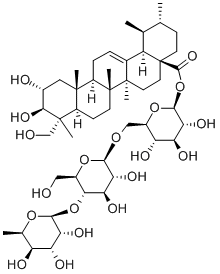
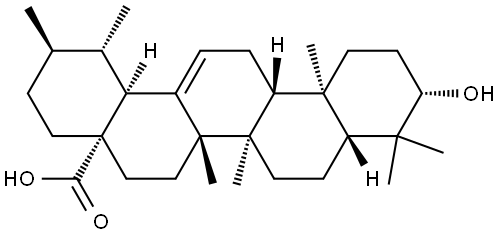
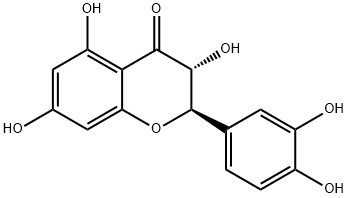
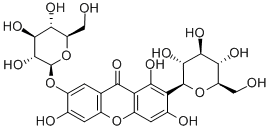



You may like
-
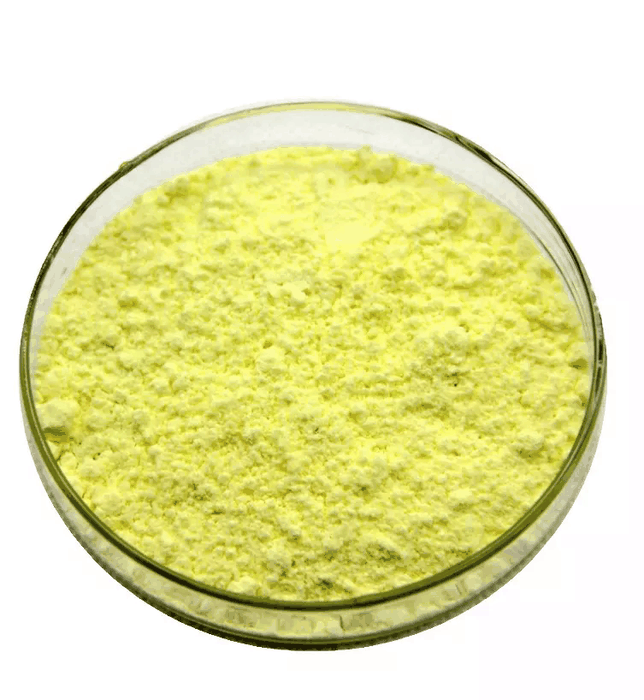 4773-96-0 Mangiferin 99%View Details
4773-96-0 Mangiferin 99%View Details
4773-96-0 -
 Mangiferin 95% CAS 4773-96-0View Details
Mangiferin 95% CAS 4773-96-0View Details
4773-96-0 -
 Mangiferin 95% (HPLC) CAS 4773-96-0View Details
Mangiferin 95% (HPLC) CAS 4773-96-0View Details
4773-96-0 -
 Mangiferin CAS 4773-96-0View Details
Mangiferin CAS 4773-96-0View Details
4773-96-0 -
 Pyridine 99.5% HPLC /UV SpectroscopyView Details
Pyridine 99.5% HPLC /UV SpectroscopyView Details
110-86-1 -
 Dibutyl PhthalateView Details
Dibutyl PhthalateView Details
84-74-2 -
 Imidazole Spot supply, competitive priceView Details
Imidazole Spot supply, competitive priceView Details
288-32-4 -
 Thiourea 99% ARView Details
Thiourea 99% ARView Details
62-56-6
